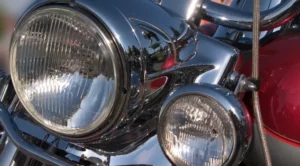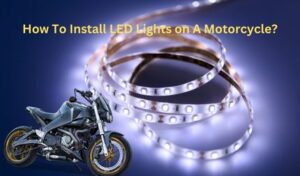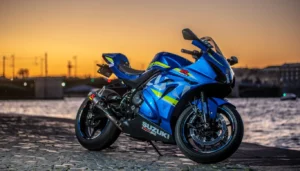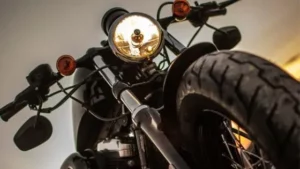When you look at a motorcycle headlight, you will see that one of the headlights is constantly on.
Are you always wondering why motorcycles only run with one headlight on instead of two? The answers to your questions are here.
Learn all you need to know about motorcycle safety, particularly, as it pertains to lighting and visibility, reasons motorcycles only need one headlight on, the types of motorcycle lights that we have, what passing lights are and when you should use them, and how to increase your visibility on a motorcycle.
Why Do Motorcycles Have one Headlight on?
Recent motorcycles have one headlight designed for normal, or low, lights. On most motorcycles, these lights are always on. The other headlight is for the high beams, which may be auto-on or can be turned on and off manually.
When the high beams are on, the low beams will remain on, but when the high beam is off, you’ll only have one headlight illuminated.
There are a lot of reasons why this change has come about. While many motorcyclist forums will assert that it’s a style choice with no utility, the choice does have a reason. This single-light system results in much lighter bikes. And, less weight is equal to more power.
Nevertheless, that doesn’t change the fact that many riders feel unsafe with only one headlight working. Since most motorcycle accidents happen because of visibility issues. No motorcyclist wants to feel invisible while they ride.
One solution to this is to turn your high beams on at all times since this will result in two working headlights. However, this can be dangerous as it can blind, annoy, and distract other motorists on the road, especially at night.
It can make sense to ride during the day with high beams on. This will make you more visible to other drivers. However, if you are riding behind a car, it’s good practice to turn the high beams off to avoid disturbing the driver. It’s important to be seen, but it’s also important to be considerate of other motorists.
Reasons of Motorcycles one Headlight on
It can be categorized into these two main points:
Functionality:
From a functional perspective, motorcycles only need one headlight with a dimmable feature to work correctly.
Because the headlights on a bike are very close to one another, to begin with, it is not necessary to turn both of them on for any reason.
Depth Perception:
One of the critical functions of headlights is for other drivers to judge how far away another vehicle is at night.
Since two headlights on a motorcycle are close together, approaching drivers cannot judge distance with any accuracy level unless only one is used.
Two headlights are much more useful on cars and trucks.
Providing more clarity to this answer, we can go back to the concept of triangulation. This is the process of measuring distance via angles.
And our brain also does this automatically when we look at an object with our eyes. The closer we are to an item, our eyes will look at it narrowly.
Types of Motorcycle Lights that We Have:
There are three different kinds of lights used in motorcycle headlights. They are halogen, Xenon HID, and LED. It’s important to know which kinds of light you have as you drive since some are much brighter.
Halogen lights
Halogen lights are the oldest lights. They aren’t common anymore, since new motorcycles use more modern lighting, but you’ll still see them on older models.
Halogen lights aren’t as bright as the others and are far less energy efficient. Even owners of older bikes often replace their halogen lights with LEDs.
Xenon High-Intensity Discharge (HID)
Xenon High-Intensity Discharge (HID) lights are the brightest type of light but are less energy efficient than LEDs.
They’re a bit of an in-between light, commonly regarded as being an improvement from halogen lights but not as good as LED lights.
One thing to note is that they have high heat emissions and are quite fragile.
LEDs
LEDs are the most common lights used today. They are much brighter than halogen lights and with low cost, low heat emission, and high durability.
Because they aren’t as fragile as HID lights and are more energy-efficient, they can last for much longer than halogen or Xenon HID lights.
In actuality, LED lights are just more efficient and brighter than other lights, and they are the best choice for motorcycle lighting.
That being said, brighter lights mean that it’s even more important not to keep your high beams on at all times, since the bright lights can impair the vision of other drivers, especially if you are driving close behind a car or another motorcycle.
What Are Passing Lights And When Should You Use Them?
Passing light is one safer alternative. These lights are not as bright as a high beam, but they give you more light than running a single headlight. By giving yourself three lights instead of one, you’ll be easier to see and therefore safer.
Many cruiser bikes already come with passing lights, and many bikers have them on at all times. Even if your motorcycle doesn’t have passing lights, they are pretty easy to install yourself for added lights.
Some motorcyclists also use driving lights to increase their visibility. What’s the difference between passing lights and driving lights? Passing lights are installed higher on the bike while driving lights are lower.
Driving lights create the same problem as high beams in that they might disturb the vision of other drivers and can cause safety issues.
There may even be legal issues with driving with your driving lights on at all times depending on where you live.
How To Increase Your Visibility on A Motorcycle?
Motorcycles are designed to have one headlight acting as a low beam and the other as a high beam.
This setup increases functionality and power, but ultimately it does lower your visibility. How can you keep yourself safe and visible while on the road, especially at night?
Upgraded Lights:
If you have halogen lights, consider an upgrade. Halogen lights just aren’t as bright, and they make it harder to see.
LEDs, in contrast, provide good lighting which will help others see you and help you see the road.
The upgrade isn’t expensive and will most likely save you money in the long run, since LEDs last so much longer than halogens.
Install Passing Lights:
If you still feel like the bike is too dark, you can install passing lights or small LED lights just to make the motorcycle a little brighter. Alternatively, reflective tape and fluorescent wheel kits are a great way to make sure you are visible to other motorists.
Clothing:
The next step to making sure you are visible on the road is to consider your clothing. Black is by far the most common choice of motorcycle jackets, helmets, and other gear.
Unfortunately, it’s also the worst for visibility. If you can stand to buy a brightly colored helmet or jacket, the color will provide a lot of additional safety.
If you can’t stand to invest in brightly colored motorcycle gear, though doing so will make you look like a racer, you can get a reflective vest instead. If you’re driving at night, in fog, or at another time with low visibility, you can slip the vest over your jacket too to be seen more easily.
Reflective vest:
Make sure you get a reflective vest meant to motorcycle riders. Just tossing on an orange construction vest won’t work, since it’ll blow around in the wind, at best case annoying and dangerous at worst case.
Add color to your bike:
A final way to make yourself visible is to add color to your bike instead of your clothes. Adding reflective tape and splashes of color make your motorcycle easier to spot than a plain black motorcycle. Always remember that being easier to see means being safer while you ride.
Conclusion
Many modern motorcycles have two headlights, but only one is lit when the high beams are off. This lowers weight and raises power, making for a more efficient ride. If you see a motorcycle with only one light, chances are it’s not because one burned out.
Many sportbikes and other motorcycles have two headlights; one for dim and one for bright. You can replace your bulbs and/or lighting system to make riding safer and also look good.
To give yourself more light, you can install passing lights and upgrade from halogen to LED lights for brighter headlights. I don’t recommend installing driving lights, as they can cause the same problem for other motorists as high beams and shouldn’t be left on at all times.
Stay safe with reflective elements, bright colors, and extra caution. If you choose to leave your high beams on while riding during the day, be considerate of other drivers and turn the high beam off if you’re driving close behind a car.






